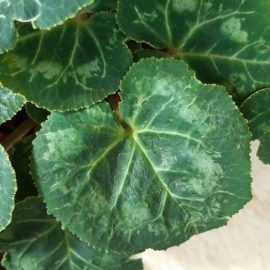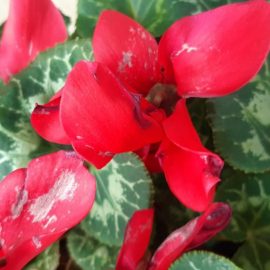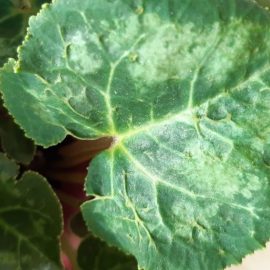Cyclamen, plant care and growing guide
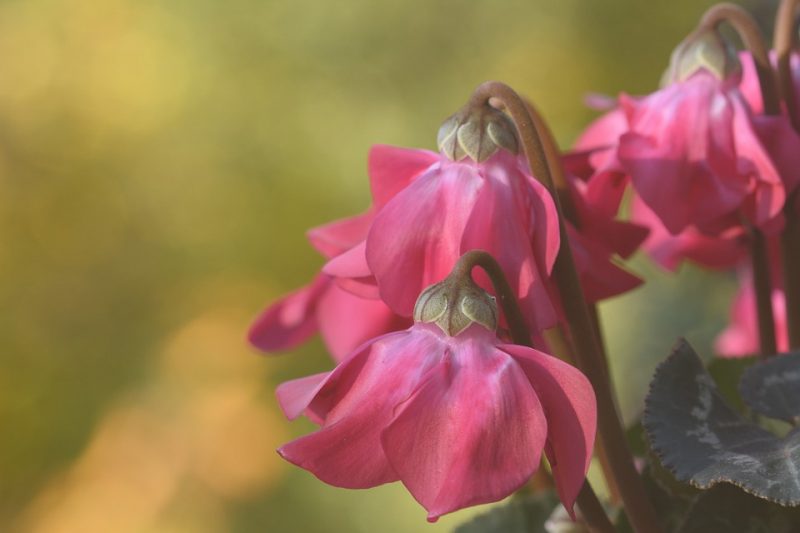
Cyclamen is a genus of perennial flowering plants in the Primulaceae family, comprising about 23 species. They originate from Anatolia and North Africa. They have heights between 5 and 30 cm, grow from tubers, and form a rounded bush. The leaves have a cordiform shape and have silvery-gray spots and ribs. They bloom between November and March, and the flowers are remarkable thanks to their petals, which are turned upwards, and colored in pink, white, red, or purple.
Species
Cyclamen persicum, a species native to North America, has green leaves with silver spots. It has flowers colored in red, pink, or purple. Cyclamengraecum has cordiform leaves and flowers colored in light pink or red. It is a species native to Southern Greece and Turkey.
Cyclamen balearicum is a species native to the Balearic islands of Spain and it is smaller in size compared to other species. The flowers are white and bloom in March – April.
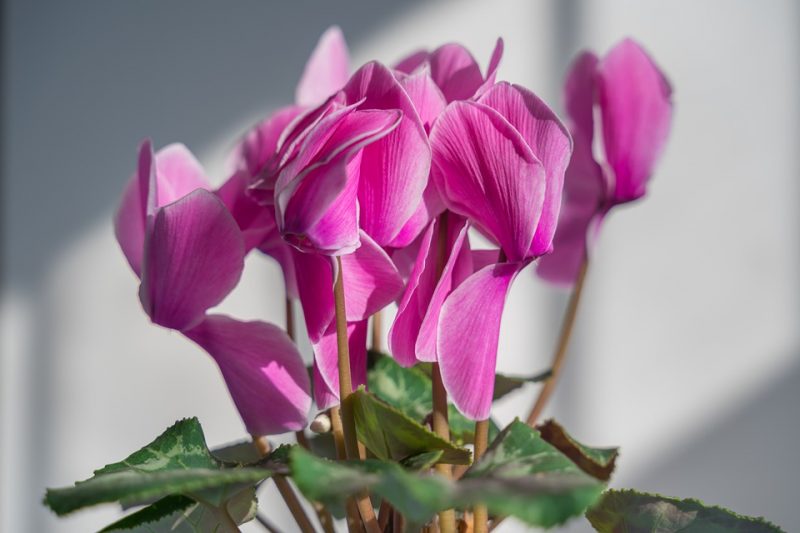
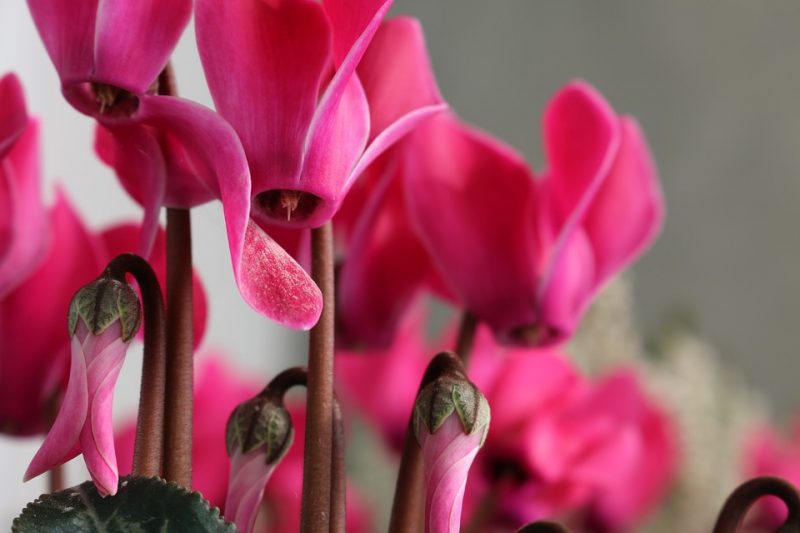
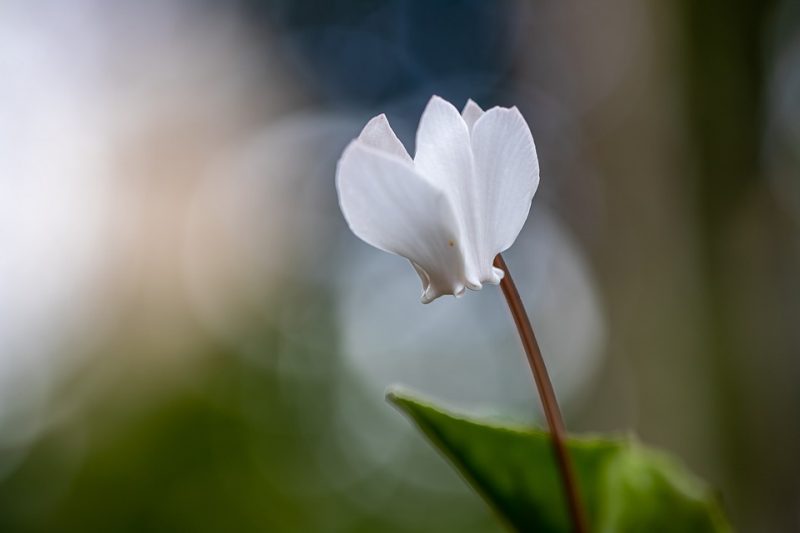
Light. During the flowering period most species need plenty of light, while during the rest of the year, it is preferable to be placed in partially shaded spaces, away from direct sunlight.
Temperature. The optimum temperature is between 18-20° C, and it should not drop below 10° C. In general, Cyclamen plants are not demanding in terms of atmospheric humidity, but spraying the leaves should be avoided.
Soil. It can be made of leaf mold, peat, and sand, in equal parts. It must drain the water very well, so a layer of gravel should be placed on the bottom of the pot.
Recommended products
-
You can find products on a different store
Change Store -
You can find products on a different store
Change Store -
You can find products on a different store
Change Store -
You can find products on a different store
Change Store -
You can find products on a different store
Change Store -
You can find products on a different store
Change Store -
You can find products on a different store
Change Store -
You can find products on a different store
Change Store -
You can find products on a different store
Change Store -
You can find products on a different store
Change Store -
You can find products on a different store
Change Store -
You can find products on a different store
Change Store -
You can find products on a different store
Change Store -
You can find products on a different store
Change Store -
You can find products on a different store
Change Store -
You can find products on a different store
Change Store -
You can find products on a different store
Change Store -
You can find products on a different store
Change Store -
You can find products on a different store
Change Store -
You can find products on a different store
Change Store -
You can find products on a different store
Change Store -
You can find products on a different store
Change Store -
You can find products on a different store
Change Store -
You can find products on a different store
Change Store
Care
During flowering, in autumn and winter, water should be administered every two days. The interval is indicative because the amount of water and the frequency of watering depends on the needs of the plant, temperature, location. In spring and summer, during the dormancy period, the frequency of watering must be reduced, so that the upper layer of the substrate is dry between you administering water again.
Fertilization. It is usually done every two weeks during the flowering period. You can use special liquid fertilizers for flowering plants or slow-release fertilizers (granules, sticks, spheres). During the dormancy period, it is recommended to stop the fertilization.
Recommended products
-
You can find products on a different store
Change Store -
You can find products on a different store
Change Store -
You can find products on a different store
Change Store -
You can find products on a different store
Change Store -
You can find products on a different store
Change Store -
You can find products on a different store
Change Store -
You can find products on a different store
Change Store -
You can find products on a different store
Change Store -
You can find products on a different store
Change Store -
You can find products on a different store
Change Store -
You can find products on a different store
Change Store -
You can find products on a different store
Change Store -
You can find products on a different store
Change Store -
You can find products on a different store
Change Store -
You can find products on a different store
Change Store -
You can find products on a different store
Change Store -
You can find products on a different store
Change Store -
You can find products on a different store
Change Store -
You can find products on a different store
Change Store -
You can find products on a different store
Change Store -
You can find products on a different store
Change Store -
You can find products on a different store
Change Store -
You can find products on a different store
Change Store -
You can find products on a different store
Change Store
Repotting. It is not necessary for this type of plant, since it is rarely kept after the flowering period.
Propagation. Propagation can be done through seeds during summer or by dividing the tubers when the plant is during the dormancy period.
Recommended products
-
You can find products on a different store
Change Store -
You can find products on a different store
Change Store -
You can find products on a different store
Change Store -
You can find products on a different store
Change Store -
You can find products on a different store
Change Store -
You can find products on a different store
Change Store -
You can find products on a different store
Change Store -
You can find products on a different store
Change Store -
You can find products on a different store
Change Store -
You can find products on a different store
Change Store -
You can find products on a different store
Change Store -
You can find products on a different store
Change Store -
You can find products on a different store
Change Store -
You can find products on a different store
Change Store -
You can find products on a different store
Change Store -
You can find products on a different store
Change Store -
You can find products on a different store
Change Store -
You can find products on a different store
Change Store -
You can find products on a different store
Change Store -
You can find products on a different store
Change Store -
You can find products on a different store
Change Store -
You can find products on a different store
Change Store -
You can find products on a different store
Change Store -
You can find products on a different store
Change Store
Diseases and pests. Excessive watering can favor the appearance of gray mold. It is always recommended to cut dry or diseased leaves and petioles. Sometimes, mites (spiders) can infest the plant.
Recommended products
-
You can find products on a different store
Change Store -
You can find products on a different store
Change Store -
You can find products on a different store
Change Store -
You can find products on a different store
Change Store -
You can find products on a different store
Change Store -
You can find products on a different store
Change Store -
You can find products on a different store
Change Store -
You can find products on a different store
Change Store -
You can find products on a different store
Change Store -
You can find products on a different store
Change Store -
You can find products on a different store
Change Store -
You can find products on a different store
Change Store -
You can find products on a different store
Change Store -
You can find products on a different store
Change Store -
You can find products on a different store
Change Store -
You can find products on a different store
Change Store -
You can find products on a different store
Change Store -
You can find products on a different store
Change Store -
You can find products on a different store
Change Store -
You can find products on a different store
Change Store -
You can find products on a different store
Change Store -
You can find products on a different store
Change Store -
You can find products on a different store
Change Store -
You can find products on a different store
Change Store
Recommended products
-
You can find products on a different store
Change Store -
You can find products on a different store
Change Store -
You can find products on a different store
Change Store -
You can find products on a different store
Change Store -
You can find products on a different store
Change Store -
You can find products on a different store
Change Store -
You can find products on a different store
Change Store -
You can find products on a different store
Change Store -
You can find products on a different store
Change Store -
You can find products on a different store
Change Store -
You can find products on a different store
Change Store -
You can find products on a different store
Change Store -
You can find products on a different store
Change Store -
You can find products on a different store
Change Store -
You can find products on a different store
Change Store -
You can find products on a different store
Change Store -
You can find products on a different store
Change Store -
You can find products on a different store
Change Store -
You can find products on a different store
Change Store -
You can find products on a different store
Change Store -
You can find products on a different store
Change Store -
You can find products on a different store
Change Store -
You can find products on a different store
Change Store -
You can find products on a different store
Change Store
In addition:
- indoors, it blooms very rarely.
- the soft petioles at the base of the plant should be removed regularly.
- spraying the leaves with water is not recommended.
- excessive watering can cause leaf wilting and root rot.














































































































































































































































































































































































































































